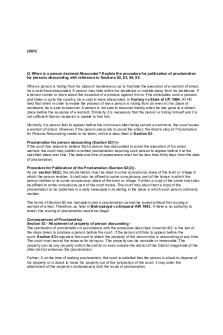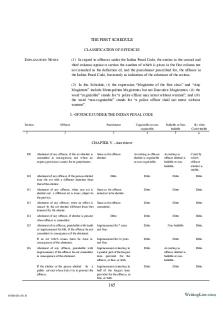Crpc brief understanding PDF

| Title | Crpc brief understanding |
|---|---|
| Author | Nithyan S P S |
| Course | Bba llb |
| Institution | Karnataka State Law University |
| Pages | 47 |
| File Size | 1.2 MB |
| File Type | |
| Total Downloads | 60 |
| Total Views | 191 |
Summary
Crpc Intro and understanding...
Description
Shri Rama Jayam
1) Constitution and powers of criminal courts under Crpc or Explain the powers and jurisdiction of different criminal courts under the Code of Criminal Procedure or Discuss the constitution of criminal courts under the code. Introduction: Indian Judiciary is one of the most efficient Judicial systems in the world. The Judiciary derives its powers from the Constitution of India. The existence of Courts is required to check the misuse of the powers conferred by the Legislature or the Executive. The Indian Judiciary is the guardian of the Constitution of India, along with being a custodian of the Fundamental Rights of the citizens. The Judiciary is well established with quite a lengthy and complex hierarchy of courts. The judicial system has been established in such a way so that it caters the need of each person of the country. The Judicial system in India is in the form of a pyramid, with the Supreme Court being at the top of the hierarchy. The hierarchy has been created in a manner that it is possible for a person even from a remote area to approach the courts to get their disputes resolved. The system is well equipped to deal with issues of the Union as well as State laws. Constitution of Criminal Courts in India The Sessions Judge– Section 9 of the CrPc talks about the establishment of the Sessions Court. The State Government establishes the Sessions Court which must be presided by a Judge appointed by the High Court. The High Court appoints Additional as well as Assistant Sessions Judges. The Court of Sessions ordinarily sits at such place or places as ordered by the High Court. But in any particular case, if the Court of Session is of the opinion that it will have to cater to the convenience of the parties and witnesses, it shall preside its sittings at any other place, after the consent of the prosecution and the accused. According to section 10 of the CrPC, the assistant sessions judges are answerable to the sessions judge. The Additional/ Assistant Sessions Judge- These are appointed by the High Court of a state. They are responsible for cases relating to murders, theft, dacoity, pick-pocketing and other such cases in case of absence of the Sessions Judge. The Judicial Magistrate– In every district, which is not a metropolitan area, there shall be as many as Judicial Magistrates of first class and of second class. The presiding officers shall be appointed by the High Courts. Every Judicial Magistrate shall be subordinate to the Sessions Judge. Chief Judicial Magistrate- Except for the Metropolitan area, the Judicial Magistrate of the first class shall be appointed as the Chief Judicial Magistrate. Only the Judicial Magistrate of First Class may be designated as Additional Chief Judicial Magistrate. Metropolitan Magistrate- They are established in Metropolitan areas. The High Courts have the power to appoint the presiding officers. The Metropolitan Magistrate shall be appointed as the Chief Metropolitan Magistrate. The Metropolitan Magistrate shall work under the instructions of the Sessions Judge. Executive Magistrate- According to section 20 in every district and in every metropolitan area, an Executive Magistrate shall be appointed by the State Government and one of them becomes District Magistrate. Powers of Criminal Courts:
Shri Rama Jayam
1. The Apex Court: The Supreme Court is the ultimate court, at the top of the Judicial system. It has the supreme judicial authority in our country. Federal Court– Article 131 gives the power of original jurisdiction to the Supreme Court, to resolve the dispute arising between the Centre and the States or between two States. Interpretation of the Constitution- Only the Apex Court has the power to settle a question based on any issue related to the Constitution. Power Of Judicial Review (Article 137)- All the laws enacted are subjected to scrutiny by the Judiciary. Court of Appeal – The apex court is the highest court for appeal in India. It has the power to hear appeals from all the cases lying in the various High Courts and subordinate courts of our country. A certificate of the grant is to be provided according to Article 132(1), 133(1) and 134 of the Constitution with respect to any judgment, decree or final order of all cases of the High Court involving the question of law. Appeals to the Supreme Court can be made under the following categories: Constitutional Matters Civil Matters Criminal Matters Special Leave Petition 2. The High Courts Original Jurisdiction – In some issues, the case can be directly filed in the High Courts. This is known as the original jurisdiction of the High Court. E.g., In matters related to fundamental rights, Marriage and Divorce cases. Appellate Jurisdiction- The High Court is the Appellate Court for the cases coming up from the trial court. Supervisory Jurisdiction- This refers to the power of general superintendence of the High Court over the matters of all the subordinate courts. The powers of the various courts have been highlighted in the Constitution of India. Apart from these courts, the power and functions of the subordinate criminal courts have been provided under the Code Of Criminal Procedure, 1973, as mentioned under section 6. Court of Session First Class Judicial Magistrate and, a metropolitan magistrate in any metropolitan area Second Class Judicial Magistrate Executive Magistrates The power of the various subordinate courts is mentioned from section 26-35, under the Code of Criminal Procedure, which has been described below. Section 26 mentions the list of Courts which are eligible to try offences – According to Section 26, any offence mentioned under the Indian Penal Code may be tried by: the High Court the Court of Session any other Court as specified in the First Schedule of the Code of Criminal Procedure Although it must be ensured that any offence committed under section 376, section 376A, section 376B, section 376C, section 376D and also section 376E of the Indian Penal Code, be tried by a woman judge.
Shri Rama Jayam
3. The Sessions Court The State Government establishes the Sessions Court which has to be presided by a Judge appointed by the High Court. The High Court appoints Additional as well as Assistant Sessions Judges. The Court of Sessions ordinarily sits at such place or places as ordered by the High Court. 4. The Magistrate Court The Magistrate judges are usually appointed by the High Court. The jurisdiction in case of Juveniles (Section 27)– Any person who is below the age of sixteen years, who is a juvenile is exempted from the death penalty and punishment for imprisonment for life. The Chief Judicial Magistrate, or any other Court specially empowered under the Children Act, 1960 (60 of 1960) or any other law for the time being in force which provides for the treatment, training and rehabilitation of youthful offenders, are eligible for trying such cases. Miscellaneous Powers Mode of Conferring Powers – Section 32 states that the High Court or the State Governments have the power by virtue of an order to empower people by their titles. Withdrawal of Powers- According to Section 33, the High Court or the State Government, have the power to withdraw the powers conferred by them under this code. Powers of Judges and Magistrate exercisable by their successors-in-office- According to Section 35, subject to the other provisions of this Code, the powers and duties of a Judge or Magistrate may be exercised or performed by their successors-in-chief. Powers of Court ( Section 26 to 35 ) 1. Courts by which offences are triable (section 26 ) In Indian Penal Code, any offence tried by: the High Court, or the Court of Session, or any other Court as specified in First schedule Provided any offence under section 376, section 376A, section 376B, section 376C, section 376D and section 376E of the Indian Penal Code, tried by a Court with women as judge. Any offence under any other law, tried by court which stated by that law. If no court stated in the law, then tried by High court or any court as specified in First schedule of the Act. 2. Jurisdiction in the case of juveniles (Section 27) Any person who is below the age sixteen years is Juveniles. Such person or juvenile exempted from punishment of death or imprisonment for life. Such juvenile cases tried by the Court of a Chief Judicial Magistrate, or by any Court specially empowered under the Children Act, 1960 (60 of 1960) or also any other law for the time being in force providing for the treatment, training and also rehabilitation of youthful offenders. 3. Sentences which High Courts and Sessions Judges passes (Section 28) A High Court can pass any sentence authorized by law. A Sessions Judge or Additional Sessions Judge can pass any sentence authorized by law. Death sentence passed by such judge needs prior confirmation of High court.
Shri Rama Jayam
An Assistant Sessions Judge can pass any sentence authorized by law. Other than death sentence, Life imprisonment and Imprisonment for period of more than 10 years. 4. Sentences which Magistrates may pass ( Section 29) The Court of a Chief Judicial Magistrate may pass any sentence approved by law. Except Death sentence, life imprisonment and also imprisonment for term more than seven years. A Magistrate of the first class may pass a sentence of imprisonment for a term not more than three years. Also fine not exceeding or both. The Court of a Magistrate of the second class may pass a sentence of imprisonment for a term not more than one year. Fine not exceeding five thousand rupees, or of both. The Court of a Chief Metropolitan Magistrate shall have the powers of the Court of a Chief Judicial Magistrate and also that of a Metropolitan Magistrate, the powers of the Court of a Magistrate of the first class. 5. Sentence of imprisonment in default of fine ( Section 30) The Court of a Magistrate may sentence such term of imprisonment in default of payment of fine as specified by law: Provided the term: does not exceed the powers of the Magistrate( under section 29); shall not exceed one-fourth of the term of imprisonment which the Magistrate is competent to inflict. Only if imprisonment awarded, part of the substantive sentence as punishment for the offence. The imprisonment sentenced under this section may be in addition to a substantive sentence of imprisonment for the maximum term awardable by the Magistrate under section 29. 6. Sentence in cases of conviction of several offences at one trial (Section 31) When a person is convicted for two or more offences, the Court may sentence him for such offence in one trial. The court may also give several punishments. Such sentences of imprisonment may commence after expiration of other. Unless courts directs such punishments run simultaneously. In the case of succeeding sentences, its not necessary for the Court to send offender before High court. If the aggregate punishment for several offences exceeds the power of court to inflict the punishment for single offence. Provided that: in no case, imprisonment should exceed the term of fourteen years; the aggregate punishment also shall not exceed twice the amount of punishment which the Court is competent to inflict for a single offence. For appeal, the aggregate punishment passed against him under this section, assumed as a single sentence. 7. Mode of conferring powers ( section 32) The High Courts or the State Government may confer some power on a persons specially by name or in virtue of their offices or classes of officials generally by their official titles. Every such order be effective from the date of appointment of such persons. 8. Powers of officers appointed ( section 33) The High court or also State government empowers any person holding an office in the service of Government. Such person has powers throughout any local area. He is equal or higher office of the same nature, as like local area under the same State Government. He also
Shri Rama Jayam
exercises the same powers in the local area in which appointed unless directed by High court or State government. 9. Withdrawal of powers ( section 34 ) The High Court or also the state Government may withdraw all or any of the powers conferred by it on any person or also by any officer subordinate to it. The Chief Judicial Magistrate or the District Magistrate may withdrawn any power conferred on any person or officer. 10. Powers of Judges and also Magistrates exercisable by their successors-in-office (section 35) The powers and duties of a Judge or Magistrate may also exercised or performed by his successor-in-office. The Sessions Judge shall determine by order in writing, the judge who, deemed to be the successor-in-office of such Additional or Assistant Sessions Judge. If only doubt arises about the successor-in-office. The Chief Judicial Magistrate, or the District Magistrate shall determine by order in writing the Magistrate, who, deemed to be the successor-in-office of such Magistrate. If only doubt arises about the Magistrate. Conclusion The Constitution of India holds the absolute authority and value in India. Hence, it becomes necessary to provide safeguards for its protection and therefore, the courts have been vested with various powers to keep a check and to ensure that no authority misuses its powers and encroaches upon others domain. The courtrooms are the places where people can take their grievances and get their disputes resolved upon the failure of other systems of the Government. The hierarchy of the Courts has been developed in such a manner that it becomes easy for everyone who is living in this country to knock the doors of the courts whenever a dispute arises. It provides a platform for the citizens for appealing to higher courts, in case they feel that justice has been denied to them by the lower courts. India is a country with a huge population in it. Therefore, it needs this existing system of Judiciary to prosper and makes its process easier, so that people can approach it easily so that Justice is given to all citizens of this country. 2) What is warrant case ? Explain the procedure for trial of warrant case or Explain the procedure of trial of warrant cases by Magistrate prescribed under Cr.pc. Introduction: In India there are two types of criminal law, one is substantive criminal law means Indian Penal Code 1860, and the second type of criminal law is procedural criminal law means Criminal Procedure Code 1973, and Indian Evidence Act of 1872. The code of criminal procedure 1973, is a procedural law, which provides a mechanism with the criminal trial to be conducted. The trial begins after the framing of charge and end with the judge's declaration. Criminal Procedure Code provides us a procedure by which a criminal trial conducted. The procedure includes the manners for the examination of witness collection of evidence, arrests, safeguards, interrogation of accused and procedure to be adopted by the police and court, bail procedure of criminal trial and use of a fair trial by the principle of natural justice. Indian Evidence Act provides a procedure for the production of the evidence in a trial and the evidentiary value, which can be attached to such evidence.
Shri Rama Jayam
That's all about the basis of the criminal trial, now we will discuss how a criminal trial set in motion. So for getting set in motion a criminal trial or criminal proceeding three methods are provided by the Cr.P.C. 1. FIR under section 154 2. Complaint to the magistrate 3. Non-Cognizable under section 155 After this, three types of Trials came into existence which are as follows:1. Trial of Warrant Case a. case instituted on a police report b. Case instituted otherwise than on the police report 2. Trial of Summons Case 3. Summary Trial WARRANT CASE: Warrant case means a case relating to an offence punishable with death, imprisonment for life or imprisonment for a term exceeding two years. Trial of warrant case begins either by the filing of FIR in a police station by filing a complaint before a Magistrate. The division of warrant case and summon case in only for the purpose of a procedure for trial.
Stages of the trial of warrant case: Trail of warrant case is also divided into two types:1. Cases instituted on a police report 2. Cases instituted otherwise than on police report The procedure of trial in warrant case by magistrates a. Compliance with section 207:- When a warrant case instituted on a police report and after that the accused appears or is brought before a Magistrate at the commencement of the trial, the Magistrate shall satisfy himself that he has complied with the provisions of section 207. b. When accused shall be discharged:- After the compliance with the sec 238, the next
step is the discharging to the accused. After considering the police report and the documents sent with it under Section 173 and making such examination of the accused, and after giving the prosecution and the accused an opportunity of being heard, the Magistrate considers the charge against the accused to be groundless, he shall discharge the accused, and record his reasons for so doing.This section should be read with the framing of charge. c. Framing of charge:- Framing of the charge is the duty of the court, that's why the
court must consider over the matter judiciously. After considering our matter, examination, hearing, if any, the magistrate of opinion that there is a ground for presuming that accused has committed an offence triable under this chapter, which such magistrate is competent to try and which, in the opinion of, could be adequately punished by him, he shall frame in writing a charge against the accused. and after that, the charge shall then be read and explained to the accused and he shall be asked whether he pleads guilty of the offence charged or claims to be tried. Trial court under
Shri Rama Jayam
which section frames charge after generally giving a brief survey of the evidence which is sought to be adduced against the accused. This section also authorises the magistrate to examine the accused if he thinks it necessary. After the framing of charge, if the accused pleads guilty, the magistrate shall record the plea and may, in his discretion, convict him thereon. d. Explaining the charge to the accused: The charge shall then be read and explained to
the accused and he shall be asked whether he pleads guilty or has any defence to make section 246(2). This section is analogous to sec 24(2). e. Conviction on a plea of guilty: If an accused person accepts the offence committed by
him, then the magistrate shall record the plea and on his discretion may convict him. f.
Fixing date for examination of witnesses:
g. Evidence for prosecution section 242:- After the framing of charge if accused refused to plead or not plead, or claims to be tried or Magistrate does not Convict the accused the Magistrate shall fix a date for the examination of witnesses. In a criminal trial, the state presents its case first. The burden of proving the accused guilty, including all the elements of the alleged offence beyond all reasonable doubt, is on the prosecution. The prosecution can call witnesses and other evidence in order to prove the offence. The process of proving guilty by witnesses is called examination in chief. The Magistrate has the power to summon any person as a witness and order him to produce any document. h. Steps to follow prosecution evidence: Accused is given the opportunity to enter upon his defence and produce the evidence to safeguard himself and if any written statement is given by accused in written form then it will be recorded by the magistrate. If the accused, after entering into defence requests the magistrate from compelling a process to present any witnesses for cross-examination purposes or to produce any document in relation to present matter. Then, he will grant the permission for that till the time he believed that it is not done with any vexation intention or to waste the time of the court, or defeating the end of justice. i. Steps to follow the defence evidence: [pg:239] Cases instituted otherwise than on ...
Similar Free PDFs
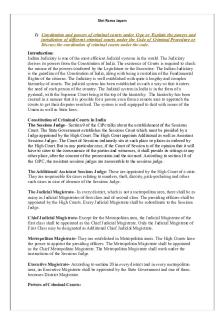
Crpc brief understanding
- 47 Pages
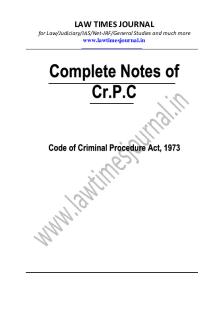
Crpc complete notes pdf
- 117 Pages
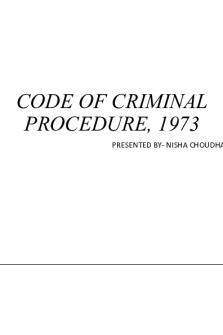
CRPC - Cr.P.C Lecture Notes
- 141 Pages
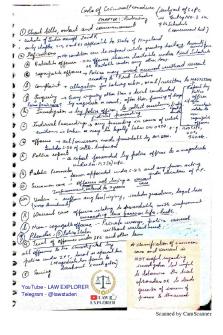
Crpc Handwritten Notes
- 41 Pages

See law Crpc mcqs
- 11 Pages

CRPC Notes for Exams
- 117 Pages

Section 6 Cr PC - Notes of CrPC
- 7 Pages
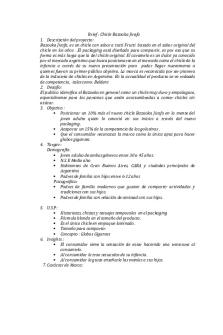
Brief
- 2 Pages

Understanding Chernobyl
- 2 Pages

Understanding Poetry
- 4 Pages

Understanding business
- 11 Pages
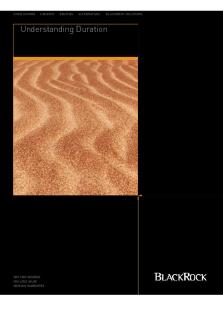
Understanding duration
- 4 Pages
Popular Institutions
- Tinajero National High School - Annex
- Politeknik Caltex Riau
- Yokohama City University
- SGT University
- University of Al-Qadisiyah
- Divine Word College of Vigan
- Techniek College Rotterdam
- Universidade de Santiago
- Universiti Teknologi MARA Cawangan Johor Kampus Pasir Gudang
- Poltekkes Kemenkes Yogyakarta
- Baguio City National High School
- Colegio san marcos
- preparatoria uno
- Centro de Bachillerato Tecnológico Industrial y de Servicios No. 107
- Dalian Maritime University
- Quang Trung Secondary School
- Colegio Tecnológico en Informática
- Corporación Regional de Educación Superior
- Grupo CEDVA
- Dar Al Uloom University
- Centro de Estudios Preuniversitarios de la Universidad Nacional de Ingeniería
- 上智大学
- Aakash International School, Nuna Majara
- San Felipe Neri Catholic School
- Kang Chiao International School - New Taipei City
- Misamis Occidental National High School
- Institución Educativa Escuela Normal Juan Ladrilleros
- Kolehiyo ng Pantukan
- Batanes State College
- Instituto Continental
- Sekolah Menengah Kejuruan Kesehatan Kaltara (Tarakan)
- Colegio de La Inmaculada Concepcion - Cebu
